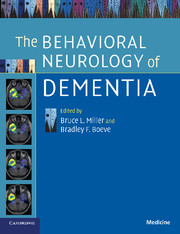Book contents
- Frontmatter
- Contents
- List of contributors
- Section 1 Introduction
- 1 Basic clinical approaches to diagnosis
- 2 Dementia with Lewy bodies
- 3 Neurogenetics of dementia
- 4 Frontotemporal dementia
- 5 Alzheimer's disease
- 6 Mental status examination
- 7 Neuropsychiatric features of dementia
- 8 Neuroimaging in dementia
- 9 Epidemiology and risk factors
- 10 Animal models of dementia
- 11 Neuropathology of dementia
- Section 2 Cognitive impairment, not demented
- Section 3 Slowly progressive dementias
- Section 4 Rapidly progressive dementias
- Index
- References
11 - Neuropathology of dementia
Published online by Cambridge University Press: 31 July 2009
- Frontmatter
- Contents
- List of contributors
- Section 1 Introduction
- 1 Basic clinical approaches to diagnosis
- 2 Dementia with Lewy bodies
- 3 Neurogenetics of dementia
- 4 Frontotemporal dementia
- 5 Alzheimer's disease
- 6 Mental status examination
- 7 Neuropsychiatric features of dementia
- 8 Neuroimaging in dementia
- 9 Epidemiology and risk factors
- 10 Animal models of dementia
- 11 Neuropathology of dementia
- Section 2 Cognitive impairment, not demented
- Section 3 Slowly progressive dementias
- Section 4 Rapidly progressive dementias
- Index
- References
Summary
Introduction
Age-related neurodegenerative diseases represent an increasing public health crisis. In the USA, individuals 85 years of age or older are the fastest growing segment of society, projected to exceed 10 million citizens before 2050. The risk of developing Alzheimer's disease (AD) doubles every five years after age 65, suggesting that the prevalence of dementia will escalate dramatically in the next 40 years.
Major advances in neuroimaging, genetics, molecular biology and neuropathology have begun to refine our understanding of the dementias, providing hope for new therapies. Structural and functional imaging studies now map dementia-related regional and network-level dysfunction in unprecedented detail, and transgenic animals provide testable disease models, bringing new insights into dementia pathogenesis. Genetic studies have identified numerous disease-causing mutations and provide a foothold for understanding the molecular pathology of dementia. Conversely, careful separation of patients with dementia into pathologically homogeneous groupings has accelerated the search for new causative mutations. Accurate prediction of pathology will become even more critical when molecule-specific treatments emerge.
With new discoveries and shifts in opinion, diagnostic frameworks for dementia have evolved rapidly. Formal clinical and pathological diagnostic research criteria for the dementias continue to be revised, with the goal of optimizing clinical–pathological correlations. However, even among patients seen at dementia referral centers, clinical and pathological diagnoses remain discordant in a significant minority of patients. Necessarily, neuropathology remains the gold standard for dementia diagnosis.
- Type
- Chapter
- Information
- The Behavioral Neurology of Dementia , pp. 142 - 160Publisher: Cambridge University PressPrint publication year: 2009
References
- 4
- Cited by

